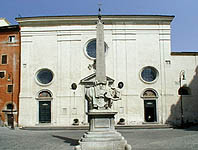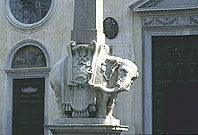St. Maria sopra Minerva
 Some of Florence's greatest names are associated with this Rome's only Gothic church: Beato Angelico, Michelangelo, Filippino Lippi and the two Medici popes.
Some of Florence's greatest names are associated with this Rome's only Gothic church: Beato Angelico, Michelangelo, Filippino Lippi and the two Medici popes.
The bland, flat (as in lack of fizz) facade with its rose window is from 1453. The infamous 19C gothic restyling can be seen inside, with the gray marble wrapping of the columns in the nave - which don't do much for Bernini's High Baroque tomb (1653) of Sister Maria Raggi, ecstasying alone and lost.
But over the centuries the interior has become an amazing museum of art treasures. Michelangelo created the statue of Christ holding his cross (1514).

The modest gold cloth is definitely not the master's! And the sandal is to protect the foot from being kissed away (left of high altar).
Antoniazzo Romano painted the gilded Annunciation (1485), (fifth chapel on right). Filippino Lippi painted the masterpiece frescoes (1489), now restored to their original beauty (main wall and over the altar) in the Carafa chapel (at the end of the transept). Its Renaissance entrance was created by Mino da Fiesole, Verrocchio and Giuliano da Maiano.
Santa Maria sopra Minerva was the headquarters of the highly repressive Dominican order, leaders in the Inquisition.
Paul IV Carafa (1555-9) the most virulent of the Inquisitor popes is buried here (Carafa chapel), as is Galileo (1564-1642), the most famous of the sages tried for heresy.
The great 15C painter Beato Angelico, a Dominican monk, is buried here (under the floor of the first chapel, left of the altar).
| St. Maria Sopra Minerva History 2C AD. Under Emperor Domitian, a charming circular temple was built near here to Minerva, goddess of wisdom. 8C. First Christian church built here. 1280. Dominican monks built this church taking the name of the nearby temple and called it St. Mary above Minerva. 1347-80. St. Catherine of Siena, "Holy Anorexia" (she was severely anorexic, living on herbs, bread and water, as did many holy women in those centuries). |
Piazza S. Maria Sopra Minerva (Map G 5)